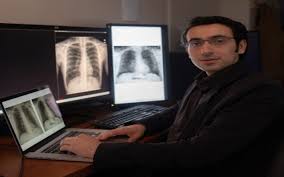Source: standardmedia.co.ke/
Artificial Intelligence (AI), sometimes called machine intelligence, is Computer systems theory and engineering capable of performing tasks that typically require human intelligence, such as visual processing, speech recognition, decision-making, and language translation.
To further expand this concept of AI in the scope of radiology results in “a computer science unit dealing with the processing, reconstruction, analysis and/or analysis of medical images by simulating intelligent human behavior in computers.”
Radiology, also defined as diagnostic imaging, is a series of different tests that take images of different parts of the body. Radiologists perform a wide array of diagnostic tests, including x-rays, ultrasound, densitometry of bone minerals, fluoroscopy, mammography, nuclear medicine, CT, and MRI.
Artificial intelligence (AI) algorithms, particularly deep learning, have demonstrated remarkable progress in image-recognition tasks. Methods ranging from convolutional neural networks to variational autoencoders have found myriad applications in the medical image analysis field, propelling it forward at a rapid pace.
Radiologists are medical professionals that are incredibly busy. They can’t really make any blunders. They need to interact with a diverse range of prescribing doctors; the list goes on with gastroenterologists, gynecologists, orthopedic practitioners. They must always be sharp. How can AI bring in and enable such stretched radiologists even better at what they’re doing?
In April 2016, Drs. Tim Dowdell, Joe Barfett, and Errol Colak – all radiologists – created the Machine Intelligence in Medicine Lab (MIMLab) in order to teach computers with artificial intelligence (AI) how to interpret medical images.
“With these AI methods, it’s very unreasonable to think that no one will ever be missing a lung nodule on a chest X-ray in the next five years,” Dr. Barfett says. “AI can span from rare to extremely rare instances like this.”
The three radiologists recruited AI specialist Hojjat Salehinejad, a Ph.D. student at the University of Toronto’s Department of Electrical and Computer Engineering, shortly after founding the MIMLab, who Dr. Barfett said is now the driving force behind their work.
The team found that AI algorithms could not be trained sufficiently to analyze X-rays using hospital databases due to instabilities in the datasets. A new solution was implemented, and the team strengthened its database by programming AI algorithms to create computer-generated chest X-rays rather than relying solely on real medical images. Enough pictures of rare conditions were produced, which, in conjunction with the real ones, gave the team exactly what it needed to teach a computer how to spot conditions on a very wide spectrum – including those rare cases that could mean the difference between a patient’s life and death.
A Stanford research created an algorithm that could detect pneumonia at that particular site in those patients participating with a better average F1 metric (a statistical measure focused on precision and recall) than the radiologists involved in that trial. During its annual meeting, the Radiological Society of North America conference incorporated AI visualization presentations. Many specialists view the advent of AI technology in radiology as a hazard, as the technology in isolated cases, as opposed to specialists, may make improvements in certain statistical metrics.
Benefits
Provide an appropriate treatment. Most AI systems are focused on delivering more info. It can be achieved via the quantifying of information contained in an image, in which it is typically only reported in a qualitative way. Or the system can incorporate universal values, enabling physicians to align patient outcomes with an acceptable boundary-section based on population.
Pick up repetitive routine tasks.AI isn’t good at all. Still not, at least. What are the correct tasks to turn over to AI at such a time? Tasks in which we have access to lots of data that are relatively straightforward and, therefore, do not demand a lot of different inputs to be merged. Therefore, radiologists do a lot of simple routine tasks. It usually includes more repetitive tasks.
Reduce inter- and intra-observer variability. With their diagnosis, even the best trained, most experienced radiologists may sometimes vary. Well rested in the morning, something else that catches your attention than after a long day’s work. In addition, different radiologists in their reports could highlight different aspects. This can be difficult for doctors to respond to, as they need to take these differences into account when synthesizing all the details they have before the final diagnosis is made. AI software can reduce or even remove this heterogeneity between reports of radiologists
AI Realizing the benefits
In the sense of radiology, there are many tasks that AI can do. Many tasks will only require a medical image as input and will depend on pixels (or voxels) to construct the
analysis. This can be done manually, but this is perceived by many radiologists as a tedious job, rendering it an appropriate candidate for some AI assistance. Some will go one move ahead, combining radiological images with other sources of information. The integration of medical images with other knowledge will lead to insights that radiologists do not always consider easy to obtain. Usually, these types of analyzes are regarded as more modern. For example, it is possible to allow an algorithm to extract pathology information from a medical image by linking image data to pathology laboratory results.
Could AI take over the work of radiologists?
The obvious answer, NO, radiologist jobs won’t be taken over. It will certainly take over certain radiologist tasks though By performing automated assessments that are currently very time consuming, it will assist radiologists. It will pick up repetitive tasks that many radiologists encounter as burdensome. However, radiologists have a much more differentiated job than just these kinds of tasks. Radiologist jobs are going to change, but they won’t go away.


